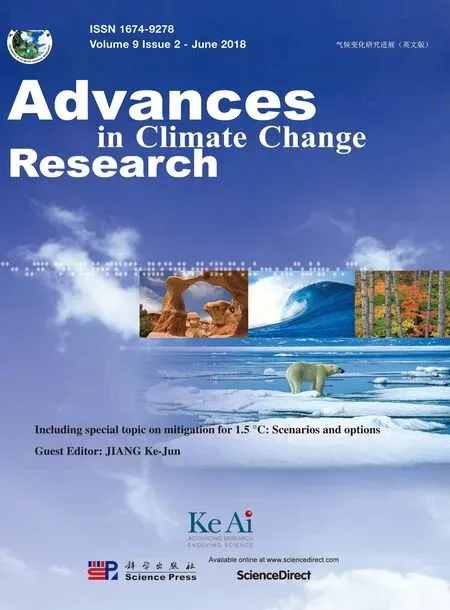1.5°C target:Not a hopeless imagination
With the proposal on 1.5°C from Paris Agreement,many studieswerelaunched to understand thevariouseffectslinking with this target,including climate science,impact,adaption,and mitigation pathway.Compared with 2°C target,mitigation pathway for the 1.5°C was given special focus.There are several international research projects made efforts on this including ADVANCE,CDLINK,EMF33 etc.(Kriegler et al.,2018;Rogelj et al.,2018;Riahi et al.,2017;Rose et al.,2017;Shiet al.,2018).These research projectsprovidegood basisto support the IPCC special report on 1.5°C,which was launched in the beginning of 2017,and will submitted to government approval in beginning of October 2018.
However,when the 1.5°C target was discussed among stakeholders on climate change,including policymakers,negotiators,researchers,NGOs,a common response is it is impossible.Even for 2°Ctarget,there isa long time argument for its feasibility.There is still not strong consensus on the feasibility of emission mitigation for the 2°C target.Now the 1.5°C target was proposed and there are much more doubt about the practical implementation of mitigation pathways for it.Many people thought this is just for negotiation to show“Ambitious”.
Almost agree with these feeling,before we run the integrated energy and environment policy model for China(IPAC)to analyze the emission scenario for China.Now the analysis fi nished,and tried to understand the feasibility.With the results,we got ourselves somewhat convinced,the emission mitigation pathway for China under the global 1.5°C target is doable,if communities in the world really want to do it.
Technology progressprovidesmoreopportunitiesfor China to go beyond the 2°Ctarget emission pathway.In 2017,newly installed capacity for solar PV power generation reached surprisingly 53 GW,which accounts for 52%of global newly installed capacity of solar PV.Much lower cost is a major driving force to the largely expansion.The solar PV cost reduced more than 40%from 2013 to 2017,and it is expected to besame cost with coal fired power generation by 2023(Shi,2017).By May 2018,there are 30 GW solar power generation newly installed,with larger size than that in 2017 in the same period.For wind power,there is almost similar story,with rapid development.Both solar power and wind power will go much beyond the planned targets by 2020,and more than the solar PV and wind power generation growth in the scenario results under global 2°C target.
Other technologies including electric car,LED,shared bike,high effi ciency air conditioner,high effi ciency refrigerator etc.,are also making surprising progress,which can signifi cantly change the future pathway of energy use and emission.LED lighting is getting to be cheapest lighting,which basically means there is no need to push this high effi ciency lighting by policies,while8 yearsago government put huge budget on Green Lighting Program to promote CFL which is 7-11 W,75%higher effi ciency than incandescent lamp(40 Was typical one).LED lighting is only 3 Wand now is only around 30%of the price of CFL.Other technologies using LED are also is high effi ciency such as LED TV.These end use technologies'progress provide good basis for lower growth rate of energy demand.
In the meantime,China's policies on air pollution control started from 2013 put strong impact on energy use in China.Driven by these air pollution control action policies,after 2012 China started to control coal use and promote clean energy use,together with economic structure change by peaking most of energy intensive products now,coal consumption peaked in 2013 in physical unit and in 2014 based on standard coal equivalent,and then continue to decline.There are 4.7%reduction in 2015,and 3.7%in 2016.With the increase of natural gas and petroleum products,CO2emission reduced after 2014.Based on the energy use data in 2016,there are around 450 Mt CO2emission reduced,which accounts for 5%of total CO2emission from energy activities.Even though considering small increase of CO2emission from clinker manufacture,CO2emission reduction still is 430 Mt.
Due to industrial structure change,energy demand increase will be quite slow,energy demand by 2020 will be much lower than the government planning.Based on scenario analysis,future newly increased energy demand could be supplied by renewable energy,nuclear,and natural gas.Coal decline will continue.Much bounce back of coal usein China is very small chance.Therefore CO2emission may already peaked,or at least no increase in future.
Looking at existing policies on energy,air pollution control,trend of energy transition toward to cleaner energy future is confi rmed.If China can do good job,it is possible that CO2emission in China is peaked,this is still consistent with the global 1.5°C emission pathway for China.
However,it is still long way to go to make decision on the implementation of 1.5°Cemission pathway.Thereisstill lack of enough researches to support the policy making process.Research societies need to move further to answer key question related with the 1.5°C target,especially regional and country based analysis.
Key factors for 1.5°C consistent pathways includes large scaleuseof Biomass Energy with Carbon Capture and Storage(BECCS)to make power generation sector negative emission by 2050,very high share of electricity in end use sectors,high energy efficient end use technologies,large scale use of renewable energy and nuclear power,new industrial processto change from fossil fuel use to electricity based process.Therefore,questions include feasibility of supply of large scale biomass by planting energy farms,water demand for such kind of rapid growing energy farms,social impact of rapid change of energy mix and related cost,progress of key technologies including energy supply technologies and end use energy technologies.In order to understand the cost and benefi t of making effort on 1.5°C target,there are also strong need to understand the impact and adaptation of temperature increase.All these remained to be the research task for researchers to make effort in their future studies.
This special issue will mainly focus on climate impact analysis and the key factors in the mitigation pathways.
 Advances in Climate Change Research2018年2期
Advances in Climate Change Research2018年2期
- Advances in Climate Change Research的其它文章
- Impact of and adaptation strategiesfor sea-level rise on Yangtze River Delta
- Development path of Chinese low-carbon cities based on index evaluation
- China's nuclear power under the global 1.5°Ctarget:Preliminary feasibility study and prospects
- Analysis on the synergistic effect of sustainable development of coal industry under 1.5°C scenario
- Changes in temperature extremes over China under 1.5 °C and 2 °C global warming targets
- Changes in surface air temperature over China under the 1.5 and 2.0°C global warming targets
